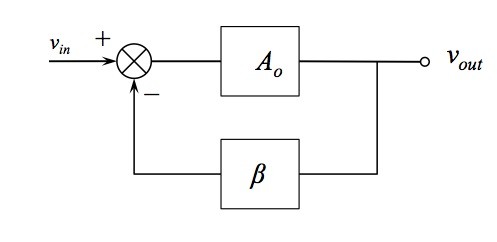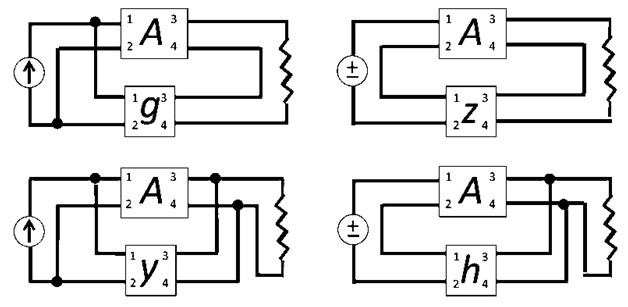Feedback amplifier is the basic design of amplifiers. The connection of these amplifiers can be done in such a way that the output is fed back to the input. However, amplifiers are devices that increase the strength of the signal. The increase in the strength of the signal can also introduce the noise in the system. Usually, these are of various types and based on the requirement of the factors, these are designed. Whenever a circuit is designed during the operations performed, then it results in the generation of noise. This noise can affect the system and this condition can be prevented by applying feedback to the system.
What is Feedback Amplifier?
Definition: An amplifier that has a feedback connection established between the output to the input is known as the feedback amplifier. There exists a feedback factor between the generated feedback signal and the applied input signal.
Feedback Amplifiers Working
In an amplifier, the output signal is generated because of the applied input signal that is again given as feedback to the input signal is known as the feedback amplifier. In this, based on the applied topologies, this amplifier works.

Block Diagram of Feedback Amplifier
Types of Feedback Amplifiers
These are basic devices and designed in such a way that the output is fed back to the input and the noise generated in the circuit due to the operations performed by it can be minimized. These are classified into two types. They are:
Positive Feedback Amplifier
The feedback applied to the input increases the input signal that can be a voltage signal. This is referred to as the positive type. It is also known as a direct amplifier. But these kinds of amplifiers are not good at amplification but can be used in the various types of oscillators.
Negative Feedback Amplifier
The feedback signal applied to the amplifier if its input signal decreases because of its application. The applied input can be of voltage or current signals. This type of feedback is known as a negative type. It is also referred to as an inverse amplifier. In this case, the noise generated in the circuit is reduced. Hence, it is most widely used in the amplification of the signals.
Feedback Amplifiers Topologies
In the feedback amplification of the signals, either the voltage or the current signals can be applied at the input of the amplifiers. Hence the topologies that are known for its series and the shunt characteristics are applied for both the voltage and the current signals. Hence the four topologies of these amplifiers are as follows:
Voltage Series
In this type of amplifier, the feedback in the circuit is designed in such a way that the output signal applied to input is in series connection. The feedback circuit to the output signal is in parallel so that there observed minimum output impedance. Whereas the feedback circuit is in series with the input signal so that impedance at this stage can be enlarged.
Voltage Shunt
In this type, the voltage signal generated at the output is fed back to the input through the feedback circuit. But in this case, the feedback circuit is connected in shunt with the input. In this case, both the input and the output are connected in shunt with the feedback circuit. Hence at both sides, the value of the impedance maintained is low.
Current Series
In this type of feedback amplification of the signals the part of the output signal that is fed back to the input signal is related in terms of series to the feedback circuit. Due to the series connection established in the output and the input signals concerning the feedback circuit thee impedance value is high at both sides.
Current Shunt
The feedback circuit connected in series for the output and parallel to the input signal is known as a current shunt feedback amplifier. Due to the parallel connection with the input the value of impedance is low at this point. Whereas the output connected in terms of series makes the value of impedance high.

Topologies of Feedback Amplifier
In this way, the topologies of the feedback amplifiers for voltage or the current signals have been classified above.
Feedback Amplifier Characteristics
The most widely preferred amplifier among the two types of the amplifier is the negative feedback amplifier. The characteristics of this amplifier are:
- In the topology of the feedback amplifiers in the voltage series feedback the input impedance value increases and the output impedance decreases.
- In the topology of the voltage shunt feedback, both the input and the output resistances values are decreases.
- In the current series feedback circuits, both the input and the output resistances are increased because of its topology.
- In the current shunt feedback topology, the amplifiers input resistance decreases and the output resistance decreases because of its connectivity of the input, output and feedback circuit.
- In this way, the characteristics are defined based on the various topologies. Each topology defined has its significance of utilization.
Applications of Feedback Amplifier
The positive feedback amplifier is good at obtaining the gain value but it results in the distortion of the signals. Hence it is not preferred during amplification. But the negative feedback consists of the characteristic that minimizes the noise levels from the system. The applications of negative feedback are listed as follows.
- It can be preferred in the regulated power supply (RPS).
- The amplifiers where the large bandwidth is required to these feedback amplifiers are used.
- It can be used in various amplifiers’ design of the electronics field.
Please refer to this link to know more about Amplifier with Negative Feedback MCQs
Please refer to this link to know more about Positive Feedback Amplifier MCQs
Hence we can give a conclusion on the feedback amplifiers with the basic block diagram and the basic topologies that enhances its functionality. It is well defined with its two basic types of positive and the negative. Whereas the negative feedback is preferred over positive feedback in the amplification of the signals. Now can you describe the practical applications of the positive feedback amplifier?